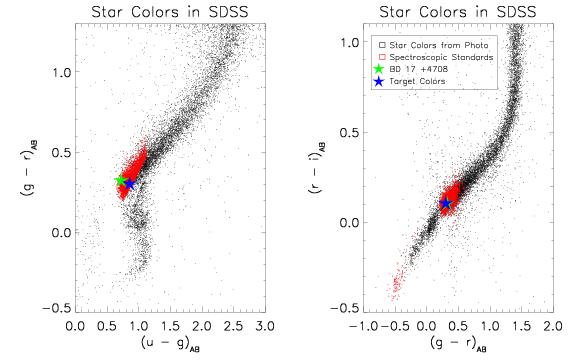
| Home |
| Where to Start |
| News and Updates |
| Tutorials |
| Data Products |
| Data Access |
| Sky Coverage |
| Instruments |
| Data Flow |
| Algorithms |
| Glossary |
| Help and Feedback |
| Search |
 |
Algorithms - SpectrophotometryBecause the SDSS spectra are obtained through 3-arcsecond fibers during non-photometric observing conditions, special techniques must be employed to spectrophotometrically calibrate the data. There have been three substantial improvements to the algorithms which photometrically calibrate the spectra (1) improved matching of observed standard stars to models; (2) tying the spectrophotometry directly to the r-band fiber magnitudes measured by the most recent version of the photometric pipeline; and (3) no longer using the "smear" exposures. A separate spectrophotometric quality page describes how we quantify these improvements. Analysis of spectroscopic standard starsOn each spectroscopic plate, 16 objects are targeted as spectroscopic standards. These objects are color-selected to be F8 subdwarfs, similar in spectral type to the SDSS primary standard BD+17 4708. 
The color selection of the SDSS standard stars. Red points represent stars selected as spectroscopic standards. (Most are flux standards; the very blue stars in the right hand plot are"hot standards"used for telluric absorption correction.) The flux calibration of the spectra is handled by the Spectro2d pipeline. It is performed separately for each of the 2 spectrographs, hence each half-plate has its own calibration. In the EDR and DR1 Spectro2d calibration pipelines, fluxing was achieved by assuming that the mean spectrum of the stars on each half-plate was equivalent to a synthetic composite F8 subdwarf spectrum from Pickles (1998). In the reductions included in DR2, the spectrum of each standard star is spectrally typed by comparing with a grid of theoretical spectra generated from Kurucz model atmospheres (Kurucz 1992) using the spectral synthesis code SPECTRUM (Gray & Corbally 1994; Gray, Graham, & Hoyt 2001). The flux calibration vector is derived from the average ratio of each star (after correcting for Galactic reddening) and its best-fit model. Since the red and blue halves of the spectra are imaged onto separate CCDs, separate red and blue flux calibration vectors are produced. These will resemble the throughput curves under photometric conditions. Finally, the red and blue halves of each spectrum on each exposure are multiplied by the appropriate flux calibration vector. The spectra are then combined with bad pixel rejection and rebinned to a constant dispersion. 
Throughput curves for the red and blue channels on the two SDSS spectrographs. Note about galactic extinction correctionThe EDR and DR1 data nominally corrected for galactic extinction. The spectrophotometry in DR2 is vastly improved compared to DR1, but the final calibrated DR2 spectra are not corrected for foreground Galactic reddening (a relatively small effect; the median E(B-V) over the survey is 0.034). This may be changed in future data releases. Users of spectra should note, though, that the fractional improvement in spectrophotometry is much greater than the extinction correction itself. Improved Comparison to Fiber MagnitudesThe second update in the pipeline is relatively minor: We now compute the absolute calibration by tying the r-band fluxes of the standard star spectra to the fiber magnitudes output by the latest version of the photometric pipeline. The latest version now corrects fiber magnitudes to a constant seeing of 2", and includes the contribution of flux from overlapping objects in the fiber aperture; these changes greatly improve the overall data consistency. SmearsThe third update to the spectroscopic pipeline is that we no longer use the "smear" observations in our calibration. As the EDR paper describes, "smear" observations are low signal-to-noise ratio (S/N) spectroscopic exposures made through an effective 5.5" by 9" aperture, aligned with the parallactic angle. Smears were designed to account for object light excluded from the 3" fiber due to seeing, atmospheric refraction and object extent. However, extensive experiments comparing photometry and spectrophotometry calibrated with and without smear observations have shown that the smear correction provides improvements only for point sources (stars and quasars) with very high S/N. For extended sources (galaxies) the spectrum obtained in the 3" fiber aperture is calibrated to have the total flux and spectral shape of the light in the smear aperture. This is undesirable, for example, if the fiber samples the bulge of a galaxy, but the smear aperture includes much of its disk: For extended sources, the effect of the smears was to give a systematic offset between spectroscopic and fiber magnitudes of up to a magnitude; with the DR2 reductions, this trend is gone. Finally, smear exposures were not carried out for one reason or another for roughly 1/3 of the plates in DR2. For this reason, we do not apply the smear correction to the data in DR2. To the extent that all point sources are centered in the fibers in the same way as are the standards, our flux calibration scheme corrects the spectra for losses due to atmospheric refraction without the use of smears. Extended sources are likely to be slightly over-corrected for atmospheric refraction. However, most galaxies are quite centrally concentrated and more closely resemble point sources than uniform extended sources. In the mean, this overcorrection makes the g-r color of the galaxy spectra too red by ~1%. Last modified: Mon Mar 15 00:30:20 CST 2004 |